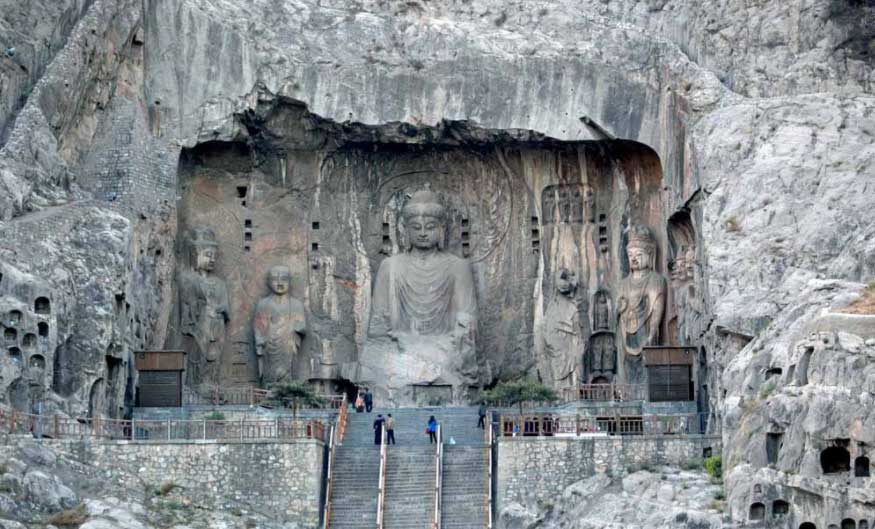After climbing dozens of steps, we can reach Fengxian Temple, where the largest Buddha statue of Longmen Grottoes is. Fengxian Temple is one of the most important Grottoes in Longmen Grottoes with the largest sculpture, the most refined art, the most majestic momentum and the most representative.

Fengxian Temple is about 40 meters deep from the east to the West and 36 meters wide from the south to the north. According to the book of the niches of the statue of Da Lu she Na on the left side of the Buddha of Lu she Na (draped Buddha), it is also built by Emperor Gaozong of the Tang Dynasty. The Buddha’s body is transparent, 85 feet high, the two Bodhisattvas are 70 feet high, and the Gaye, Ananda and King Kong are 50 feet high each. According to relevant materials and experts, the construction time of Fengxian Temple was about six years after Empress Wu Zetian was established as empress Yongwei, that is, after 655 ad. It took about 21 years to complete the project in the second year of Shangyuan, i.e. December 30, 675 A.D.
Please see the layout of Fengxian Temple: one Buddha, two disciples, two Bodhisattvas, two heavenly kings, two powerful people, and two other supporters. According to Buddhism, Buddha has three bodies: the Dharma body is the original body of the Buddha; the body of reporting is the body of “Buddha fruit” obtained by the long-term practice of the Buddha; the body of responding is the body of the Buddha appearing for “transcending all living beings”. Lushena, the so-called Buddha who reported himself, is translated as “jingshamed”. The main statue is Lu shezhaoxi in the center of the initial position. The total height of the statue is 17.14 meters, including 4 meters in the head and 1.9 meters in the ears. It is the largest Buddha sculpture in Longmen Grottoes. His face is plump and elegant, his eyebrows are like crescent moon, his eyes are affectionate, his smile is slightly exposed, and his kindness is overflowing. Her intelligent eyes, looking down slightly, meet the gaze of the worshippers, which can cause people’s emotional tremor. This shows the designer’s ingenuity and artistic charm. The two disciples on both sides, the old JIAYE, are strict and serious in image, while the young Ananda is full and round in image, with a clear face. Depending on the Bodhisattvas wearing a crown, wearing a wreath, wearing Pei silk on their shoulders, and wearing a long skirt, they have the potential to emerge from the water. The statue depicts a dignified, beautiful and moving style. The whole layout of Fengxian Temple makes people feel like the scene that the emperor is calling for all kinds of officials.

Generally speaking, in the Buddhist doctrine, both Buddhas and Bodhisattvas are male, while the main Buddha in Fengxian Temple of Longmen is female. This is because of the political needs of Wu Zetian of Tang Dynasty, who is out of his own ingenuity. For the first time, she created the unique image of middle-aged women with the Great Buddha of Lushena. It is said that the above virtues of Wu Zetian are almost identical with the image of the Great Buddha of Lucena. It can be seen that the image of Lushena is to some extent the true portrayal of the image of Empress Wu.
From the artistic point of view, the layout of Fengxian Temple statues is harmonious. The depiction of the five features of the Great Buddha is in line with the proportion, which is a brilliant achievement of wonderful craftsmanship and has an indelible artistic charm. It is a summary of religious art in Tang Dynasty and one of the great examples in the history of sculpture in China.